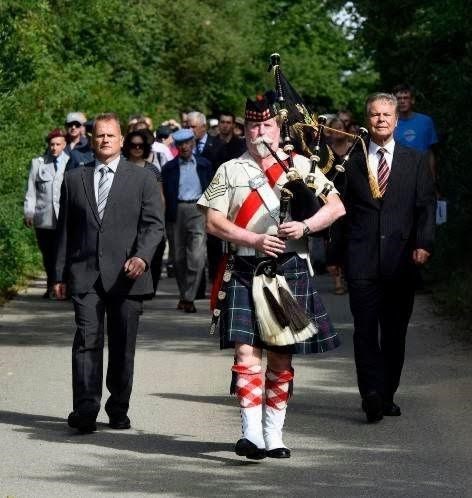Eighteen relatives of World War 2 soldiers travelled to the field in Germany where their loved ones were killed in battle 75 years ago.
For the first time, family members of each of the airmen witnessed where they died and saw the unveiling of a special memorial stone.
Among the crowd were relatives of Flight Sgt. Hugh Coles MacMillan, an airman from Nobel near Parry Sound.
MacMillan was killed along with six others from Great Britain and New Zealand when their R.A.F. bomber of 90 Squadron crashed on the night of Sept. 5/6, 1943.
MacMillan's niece Elizabeth spoke at the ceremony.
"It is a great honour for my daughter Charli and myself to represent the family of Hugh MacMillan. When we where notified of this event we were pleasantly surprised that, after almost 75 years, the family of Hugh and his fellow crew members would be invited to gather here, with you, for this ceremony," MacMillan said.
"My Grandparents, like all other parents in a similar situation, were devastated to receive the telegram that told them of Hugh's death."
MacMillan said it was her Uncle Hugh's first trip out of Canada. His letters home spoke of his fellow crew members, his aircraft, his trips to Scotland to visit family and his time in London, she said.
"He never discussed any of the difficulties of war except to complain about the quality of the cigarettes," MacMillan recounted.
A bagpiper and bugler were part of the memorial service held Aug. 5 in a field in Limburgerhof, Germany where MacMillan’s Canadian relatives were joined by local and military dignitaries.
"This morning ceremony, when you feel you can almost touch the lives of those you loved so dearly, will make your connection to them even more profound and your memory of them everlasting," said the Honourable Dr. Peter Kern, Mayor of the Municipality of Limburgerhof.
"The names of those who lost their lives after going through so much injustice, pain and suffering, will stay written on this roadside monument in order to make us remember, mourn and always be vigilant."
The service was organized by Erik Wieman, co-founder of a volunteer research team called IG Heimatforschung Rheinland-Pfalz.
The group recovers remnants from crash sites and provides the families of airmen killed in action with keepsakes of the wreckage.
They have discovered over 20 wrecks, including the site of MacMillan's R.A.F. bomber.
In Nov. of 2016, Wieman put out a call for help to local media to find MacMillan’s family members to tell them about the project.
MacMillan was the only Canadian on board and his relatives were the final piece of the puzzle Wieman needed to complete his mission.
"Dr. Wieman, thanks to your fervent committment and your work these fateful events will not be covered by a coat of silence," the mayor said.
"The place where we are today is a place where unknown fates can be called by their true names again. Through our attention we can give them back their dignity," said Lieutenant Colonel Dr. Ullrich Graf, German Air Force.
"These young men of flight EF129 have paid the highest price any soldier can pay. They gave their lives for their country to evict a criminal regime from Germany. They deserve our highest respect," he said.
"The families of the killed airmen and the airmen themselves deserve that our society remembers their sacrifice and do not forget. We will remember these young men."
Over two-thousand plane parts were found at the site.
Underneath the plaque there is a place left for a picture of all the relatives and RAF/Airforce, the mayor and the researchers who made it all happen.
"It is wonderful that we can come together, in friendship, making a choice to remember what was lost. It amazes me how far we have come - from adversaries in a war to allies at this peaceful ceremony we are having today," MacMillan said.



